Popular Press, Recent – Mark Lucente, Ph.D.

on Holographic Displays / Holographic Video
Below is a list of recent press coverage of work on holographic display systems and holographic video systems, led by Mark Lucente.
For more information, contact Mark Lucente.
For older press, see the Press Archive.


Holograms: you can find some real ones in Austin

For more information, see holographic display details.
In addition to this newspaper article and its companion blog entry, this story was picked up elsewhere: Pinoy Technologies; Dayton Daily News; etc.
Out of the Box – 3-D entertainment steps beyond the glasses and headaches
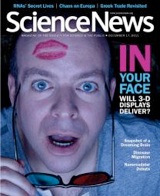
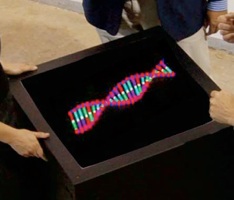
This article is well written and provides terrific coverage of the recent advances in holographic display systems and advanced “3D” displays. It includes the holographic display and technologies developed by the Zebra team (led by Mark Lucente) from 2005 to 2010, funded generously by DARPA. The article includes interesting quotations. For example, Dr. Darrel Hopper seems to be quite pleased; he and his group are pioneers in many ways -- not the least of which is their status as the first-ever customer for a holographic display system. It’s nice to see mention of the ongoing work at the MIT Media Lab. Also, good to see the reference to Forbidden Planet and the Krell holographic display used by Dr. Morbius. [Kudos to Professor Ken Perlin for reminding us all that the oft-mentioned Princess Leia “hologram” was inspired by Forbidden Planet.]

WPAFB: Program pushes money toward small businesses –
AF program steers money toward small businesses
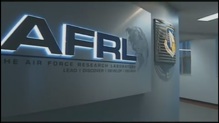
This TV news spot describes the robust Air Force SBIR program out of Wright-Patterson Air Force Base (WPAFB), home of the AFRL (Air Force Research Laboratory). Included is a brief description of the holographic display prototype developed by the Zebra team (led by Mark Lucente) from 2005 to 2010, funded generously by DARPA. The Air Force was the first-ever customer for a holographic display system, and they appear to be big fans of the prototype [see story from Dec 14]. This story emphasizes the Air Force Small Business Innovative Research (SBIR) program, using the the holographic display prototype as a prime example – quite a compliment considering that there are hundreds of on-going AF SBIR efforts!

Zebra Imaging Delivers First Holographic Display to U.S. Air Force
‘The United States Air Force accepted the world’s first true 3-dimensional (3D) holographic display with Zebra Imaging’s delivery of the Full Motion Holographic Display (FMHD), integrated with NASA World Wind software, to the Air Force Research Laboratory (AFRL), 711 Human Performance Wing, Human Effectiveness Directorate, Decision Making Division, Battlespace Visualization Branch at Wright-Patterson AFB OH. The display will be demonstrated and evaluated at AFRL for USAF mission applications, and used to develop 3D metrics.... developed by Zebra Imaging and refined in partnership with AFRL, DARPA and other government agencies.... executed under AFRL contract and Program Manager Dr. Darrel Hopper, and integrated the user software application World Wind developed by the National Aeronautics and Space Administration (NASA,) with the holographic display for evaluation and application to air, space and cyberspace warfare missions. This delivery culminated a transition partnership with the Defense Advanced Research Projects Agency (DARPA) Urban Photonic Sandtable Display (UPSD) project.... The delivery and installation at AFRL was a major milestone within the continuing, on-going SBIR Phase 2 of the Air Force funded FMHD program that was initially awarded to Zebra Imaging in May 2010. “This delivery is the first time a true, dynamic, holographic display is in the hands of a user,” says Zebra Imaging’s FMHD Project Manager, Amy Lessner, “and the excitement from AFRL and Zebra during the installation was astounding. The missions of the US Air Force are inherently three dimensional, and even four dimensional. This technology can revolutionize situational awareness, command and control, and decision making across many Air Force missions.”
[The Zebra holographic display’s] key features provide distinct advantage over two-dimensional displays. With full-parallax functionality base on holographic element (hogel) light fields, and 360-degree viewing, [it] allows user interaction within three dimensions, including zoom, rotate, as well as select and manipulate any part of the image they are viewing. The full parallax capability, along with the lack of eyewear,... produce a 3D display that can be viewed for long periods without negative physiological effects on viewers. “Zebra looks forward to the continued relationship with the Air Force, and Dr. Hopper, in pursuit of holographic visualization. Comfortable, sustained, intuitive use of 3D information, by simultaneous viewers in air, space, and cyberspace operations centers, and eventual application to airborne or other environments are among our long term objectives,” concludes Ms. Lessner.’
This article describes an important milestone in the Air Force SBIR program. Included is a brief description of the holographic display prototype developed by the Zebra team (led by Mark Lucente) from 2005 to 2010, funded generously by DARPA. The Air Force was the first-ever customer for a holographic display system. Exciting times: getting real holographic 3D into the hands of real users will provide guidance for the industry for years to come!

50 Best Inventions Of The Year – The Holographic Map
‘The Urban Photonic Sandtable Display is a holographic map that shows buildings and terrain in full color and three glorious dimensions — no goofy glasses required. After the real-world landscape is swept by unobtrusive lasers, software created
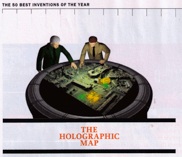
This article covers 50 inventions, one of which is the holographic display developed by the Zebra team (led by Mark Lucente) from 2005 to 2010, funded generously by DARPA. Time’s selection of this holographic display as one of the best 50 inventions of 2011 was covered in a number of related articles (below), and mentioned elsewhere, including ITbriefing.net and Global Plant Automation.
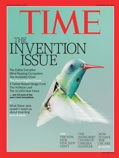
TIME Magazine Recognizes DARPA’s Holographic Sandtable Display
Advanced 3-D mission planning technology makes TIME’s 2011 50 best inventions list
‘Military teams have gathered around mission planning sand tables for centuries, but in the future they may have a more realistic and interactive simulation tool. DARPA’s Urban Photonic Sandtable Display (UPSD) pioneers an advanced 3-D technology that creates a real-time, color, 360-degree, 3-D holographic display that could assist battle planners. TIME Magazine honored the UPSD and DARPA’s Nano Air Vehicle Hummingbird, a robotic air vehicle that looks and flies like a Hummingbird, as two of the best 50 inventions of the year. "The ability to dynamically display three dimensional data and video to an audience gathered around a sandtable – without the need for special glasses or equipment – represents a significant step forward in our ability to more naturally synthesize and interact with a virtual world in an intuitive way,” said Don Woodbury, director, Strategic Technology Office. “With UPSD, DARPA has opened the door to a new approach to training, mission planning and data visualization.”
A team of up to 20 planners can view the UPSD’s large-format, interactive 3-D display. It’s an example of DARPA’s commitment to advancing technology to support the war fighter. Adding fidelity and real-time 3-D terrain data is expected to enhance mission planning. “This recognition for military technical innovation is a credit to the quintessential DARPA program manager,” said DARPA Director, Dr. Regina Dugan. “They are technical visionaries, best-in-class scientists and engineers, who are determined to make a difference for our warfighters. They come from diverse backgrounds in academia, industry, laboratories, non-profits; they come to DARPA to serve their country.”
UPSD demonstrates a unique technology which enables each 3-D holographic object to project the correct amount of light that the original object possessed in each direction, for full 360-degree viewing.
The holographic sand table technology is part of DARPA’s broader efforts in 3-D technology research, such as wide-area, 3-D LIDAR (Light Detection and Ranging) mapping under DARPA’s High Altitude LIDAR Operations Experiment (HALOE). Through HALOE, forces in Afghanistan are receiving unprecedented access to high-resolution 3-D data. UPSD’s display can support the rapid exploitation of this data for detailed mission planning in diverse terrains: rugged, mountainous, or complex urban terrains.’
This release describes the holographic display developed by the Zebra team (led by Mark Lucente) from 2005 to 2010, funded largely by DARPA. Nice to see DARPA touting the fruits of their generous support! Terrific quotations! This press released was picked up in a number of places, including Headline News Online.
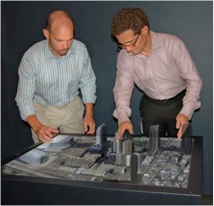
DARPA’s Hummingbird Nano Air Vehicle And Holographic Display Among Time’s 2011 Best 50 Inventions
‘Advanced 3-D mission planning technology makes TIME’s 2011 50 best inventions list:
“Advances at DARPA challenge existing perspectives as they progress from seemingly impossible through improbable to inevitable,” said, DARPA Director Dr. Regina Dugan. UAVs from the small WASP, to the Predator, to Global Hawk now number in the hundreds in Afghanistan. What once seemed inconceivable is now routine.
“At DARPA today we have many examples of people – national treasures themselves – who left lucrative careers, and PhD programs, to join the fight,” Dugan said. “Technically astute, inspiringly articulate, full of ‘fire in the belly,’ they are hell-bent and unrelenting in their efforts to show the world what’s possible. And they do it in service to our Nation.” TIME Magazine also recognized DARPA’s innovative breakthrough in 3-D holography, the Urban Photonic Sandtable Display, among its top 50 inventions. The holographic sand table could give war fighters a virtual mission planning tool by enabling color 3-D scene depictions, viewable by 20 people from any direction—with no 3-D glasses required.’
This article is a recap of the Nov 23 press release by DARPA. It describes the holographic display system and technologies developed by the Zebra team (led by Mark Lucente) from 2005 to 2010, funded largely by DARPA.
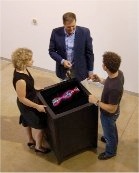
Zebra Imaging's ZScape Motion Display Named a TIME Magazine "Best Invention of the Year"
‘[R]eal-time holographic ZScape™ Motion Display was named one of TIME's 50 Best Inventions of 2011. The ZScape™ Motion Display is the world's first real-time, full- parallax, interactive holographic light-field display.the world's first real-time, full- parallax, interactive holographic light-field display.... TIME Magazine's recognition of this new 3D holographic technology is further validation of the truly innovative nature of this breakthrough capability.... "This honor caps years of research and multiple scientific breakthroughs to bring holographic 3D video to a variety of markets..." said Al Wargo, CEO of Zebra Imaging.’
Nice synopsis, referring to the holographic display developed by the Zebra team (led by Mark Lucente) from 2005 to 2010, and funded largely by the generous support of DARPA. This press release was reiterated by a number of publications, including MarketWatch, fedscoop, ThomasNet News, KCEN TV in Texas, The Sacramento Bee and others.
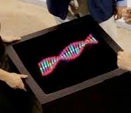
Interactive 3D Holographic Display
‘DARPA teamed up with Zebra Imaging, company that creates digitally-mastered, full-colored holographic images, to create a real-time, 360-degree 3D holographic display. The latter would be used to assist battle planners. The project is called the Urban Photonic Sandtable Display (UPSD). With the new system up to 20 users will be able to observe a large-format, interactive 3D display without special glasses. Specialists at DARPA mentioned that the invention will not only help team-based mission planning, but will also be used to assist visualization and interpretation of sophisticated 3D data like intelligence and medical imagery.’
For more information, see holographic display details.


Zebra Imaging Awarded 3D Medical Simulation Contract

“The Medical community employs a wealth of 3D data but has limited tools to display the data collected,” says Amy Lessner, PMP®, Zebra Imaging Project Manager for MedSim. “ZScape Motion Display technology will unlock the full potential of the three-dimensional data sets the medical community has been collecting for years.”’
This is a follow-on regarding one of the first transition programs, branching out of the 6-year DARPA-funded effort (led by Mark Lucente) to develop the first-ever scalable holographic display technology and prototypes. Good to see that 3D holographic display technology is beginning to be integrated into these important applications. Terrific line-up of participants, which includes big-brained BBN (now part of Raytheon), in the Boston area.
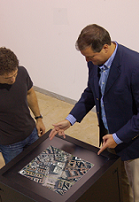
ARL STTC Awards Contract For Holographic And 3D Medical Imaging
‘the U.S. Army Research Laboratory’s Simulation and Training Technology Center (ARL STTC) announced a $2.8M contract award to Information Visualization and Innovative Research (IVIR) Inc. to investigate the use of holographic and 3D imaging for medical simulation and training. The effort will investigate current holographic and 3D technologies and their potential uses for medical modeling and simulation. Holographic and 3D displays will provide medical professionals with enhanced visualizations of human anatomy and physiology usable for education, training and surgical practice. High fidelity anatomy models will be developed for display within this effort. These models will be displayed holographically using the DARPA developed Urban Photonic Sandtable Display, as well as on traditional 3D televisions. Additionally, this research will develop a new 3D after action review capability using a position tracking light detection and ranging system. It will be evaluated for a number of purposes, including review capability for combat medics participating in medical training tactical field exercises. The system will track personnel using the LIDAR system and then have the capability to replay the exercise in 3D, allowing for additional detail during exercise review. The Armed Forces Simulation Institute for Medicine has collaborated and funded the effort with ARL. For this effort, IVIR Inc. has partnered with the University of Minnesota Medical School, Zebra Imaging, and Bolt, Beranek and Newman (BBN).’
This release covers an exciting program that helps to transition holographic display technology created during the 6-year DARPA-funded effort (led by Mark Lucente) to develop the first-ever scalable holographic display technology and prototypes. This article echos the press release, which includes a good overview of goals and opportunities in the medical simulation and training space. A related story includes more detail: ‘8 August 2011: IVIR Inc. was awarded a $2,746,000 contract by the U.S. Army Research, Development, and Engineering Command (RDECOM) Army Research Lab, Human Research Engineering Directorate, Simulation and Training Technology Center (ARL HRED STTC) for “Holographic Imaging Technologies Applied to Medical Modeling and Simulation.” This effort is a cutting-edge research and development program that will investigate current holographic imaging technologies, their potential uses, and begins their integration with existing medical modeling and simulation systems. The hologram technology applied to human anatomy offers an alternative to current medical education anatomical visualization that can provide sufficient perspectives to mitigate medical errors and ultimately facilitate surgical mission rehearsal. Additionally, a light detection and ranging (LiDAR) 3-D after action review capability will be evaluated for use in medical training during tactical field evaluation.’
The full scope of applications is very exciting. Congratulations to the technical and contracts team for making it happen!

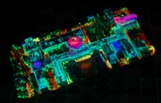
PHOTONIC FRONTIERS: DARPA PROJECTS: DARPA's photonics projects – At the edge of possibility
High-risk, high-payoff research is DARPA’s charter. The agency tackles a wide range of photonics challenges, including building high-energy lasers compact enough to get off the ground, combining laser beams, and devising real-time 3D holographic displays. DARPA is investigating many other photonic technologies and the list changes regularly because of the agency’s philosophy of exploring the cutting edge.... One recent success is the Urban Photonic Sandtable Display (UPSD) program, which created a real-time, color 360° 3D holographic display to assist battle planners.... The system has full parallax, 12 in. of visual depth, and accommodates up to 20 viewers without special glasses, making it much more flexible than previous 3D displays. The current version, developed by Zebra Imaging (Austin, TX) over a five-year period, can be scaled from 6 in. to 6 ft in diagonal size. DARPA has transferred the technology to the Army and Air Force for further development.
Nice overview of recent successes funded by DARPA, including the 5-year UPSD program that led to the first-ever scalable holographic display system.

2011 July 7: Schubin Cafe article
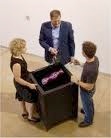
In this article, Mark Schubin wrote an excellent synopsis of a truly exciting SMPTE conference on 3D in New York City. Though the conference was necessarily centered on the two-view stereoscopic technologies of today, it did feature some future technologies that are under development. The comments regarding holographic video mentioned one apparent contradiction about the oldest work in holographic video – the discrepancy being simply that theoretical work dates back to the 1960s (or earlier), while experimental implementation began at MIT roughly 20 years ago.

‘If you think today's 3-D technology in movies and TV shows is cool, wait until you see your first hologram table. Funded by DARPA, the Defense Department's research arm, for battle planning, the Urban Photonic Sandtable Display produces a 360°, 3-D image (no glasses needed). Zebra Imaging, the company that is developing the technology, says it'll take at least another three years before this table is set for business applications like surgical planning or even gaming, but that won't stop us from thinking about the possibilities now. Here's how it works. Virtual models: Detailed 3-D renderings are created from standard design software or Light Detection and Ranging (LIDAR) devices that sweep real-world buildings and objects with invisible lasers.... The display: Processors and graphics-processing units inside the display crunch the data and send it through a light modulator and a set of [optics] to create an image made up of millions of "hogels," the 3-D equivalent of pixels.’
Nice overview of the holographic display system and its applications. There are a few minor misconceptions, mostly due to the necessarily simplified description. Wonderful artist’s interpretation of the imagery produced by the display – although it does feel that fantastic when one actually sees the display in action!
The Obscure Government Agency Trying to Predict the Future
IARPA says it ‘seeks dynamic, high-performance, synthetic holographic 3D workstation display systems, simultaneously viewable by multiple people with the unaided eye’. This is believed to be inspired in part by the holographic display and technologies developed by the Zebra team (led by Mark Lucente) from 2005 to 2010, funded generously by DARPA.
Spy Geeks Want Holodeck Tech for Intel Analysts
‘IARPA, the intelligence community’s advanced research outfit, announced this month that’s it’s embarking on a Synthetic Holographic Observation (SHO) program, a quest to build a system that lets intel analysts collaborate with each other using interactive 3-D holographic displays.’
This is a fun look at the results of the recent development of a scalable holographic display system, and follow-on work solicited by IARPA, i.e., the Synthetic Holographic Observation program that is (as of mid-2011) in the proposal stages.

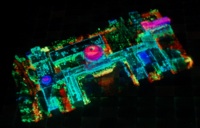
DARPA Successfully Completes 3D Holographic Display Technology Demonstration Program
‘The Defense Advanced Research Projects Agency (DARPA) recently completed a five-year program called Urban Photonic Sandtable Display (UPSD) that creates a real-time, color, 360-degree 3D holographic display.... Zebra Imaging of Austin, Texas, was awarded the initial contract in 2005 and has researched and developed the technology.’
This is one of the major programs that has led to the development of holographic video from the lab to a more practical prototype and (soon) to a production product. An honor to have a link-through from the DARPA homepage! See the the holographic display web page for more information on the Zebra motion display system. Also, a video of the holographic display is on the Zebra website. This release was picked up in multiple locations (see below), including geoplace.com.
Army, Air Force Get 3D Battle Planning Technology
‘Through a five-year program called the Urban Phototonic Sandtable Display (UPSD), the Defense Advanced Research Projects Agency (DARPA) created a real-time, 360-degree, 3D holographic display to help military commanders and mission planners better visualize and plan battles.... large-format, interactive 3D display that enables full visual-depth capability up to 12 inches, the agency said.’
Small but important error: ‘UPSD also produces two-dimensional [sic] printouts of the 3D imagery rendered onscreen so troops can use them in the field as guides.’ Actually, three-dimensional holographic prints can be generated by Zebra technology. See the the holographic display web page for more information on the Zebra motion display system.
2011 March 25: VizWorld.com article by Randall Hand
DARPA's 3D Holographic Display Technology
‘The Defense Advanced Research Projects Agency (DARPA) has just completed a 5-year project called “Urban Photonic Sandtable Display”, or UPSD, that creates realtime, color, 360-degree 3D holographic displays. Without any special goggles, an entire team of planners can view a large-format (up to 6-foot diagonal) interactive 3D display.... The technology was developed by Zebra Imaging, and is currently being deployed to an Air Force lab and two Army labs for use.’
Very relevant pick-up by Randall Hand, a leading visualization scientist, who works at Lockheed Martin in Mississippi. This brief article echoes the DARPA press release, and includes a photo of warfighters using Zebra’s print holograms (that’s the hardcopy holographic imaging, not the dynamic electronic display systems described in the DARPA press release).

DARPA's Urban Photonic Sandtable Display enables 3D battlefield planning without goofy glasses
‘You probably point and laugh at your friends when they have big, bulky 3D glasses perched on their noses in theaters. This new 3D system, called the Urban Photonic Sandtable Display (UPSD), should help. It's a DARPA project, a fully holographic table (no glasses required) that can be scaled up to six feet diagonally and allows visual depth of up to 12-inches. The technology comes courtesy of Zebra Imaging’
This article covers the DARPA press release,and appears in a number of places, including BusinessInsider.com, Crunchdot and Iyaan.Info. It was picked up on the The Book of THoTH website, which has alternative views (e.g., one post posits ‘Reverse engineered alien technology?’); nevertheless, it included this insightful comment: ‘Wow, pretty impressive videos and holographic technology. This capability is great for viewing models constructed and then holographically imaged as they are showing in the videos. What would really be cool if actual satellite images could be rendered holographically.’ Note: the Zebra holographic motion display, like the print holograms, does indeed create images based on actual satellite data (as is later mentioned).
DARPA Creates Interactive 3-D Holographic Map Table
‘Long gone are the days of pushing plastic armies around hand-drawn maps. Today’s military planners deserve technology of the future, and that means nothing less than 3-D holograms will do. Luckily, we have DARPA, ever-ready to step in with a solution.’
This article helps to explain one of the many uses for the Zebra holographic motion display. The comments are interesting. One posting asks about ‘video’; a video of the holographic display is on the Zebra website. Another urges ‘Now lets use this technology for a less destructive purpose, things like engineering and planing rescue missions.’ In fact, the Zebra holographic motion display. has been used to demonstrate a number of related uses, including urban planning, 3D content creation (e.g., CAD, architecture), first-responder situation awareness, weather modeling and prediction, and resource management (e.g., water).


Holographic TV May Make 3-D TV Ancient Before It Takes Off
‘If wearing 3-D glasses makes you feel like we haven't progressed much since the 1950s, you are not alone.... It’s the result of decades of research that began with MIT’s Stephen Benton, who built the first holographic video display in the late 1980s.... Mark Lucente, director of display products for Zebra Imaging in Austin, Texas, which is commercializing holographic displays for videoconferencing applications, says that his company’s prospective customers are often uncomfortable with the sheer computational intensity of holographic video. “It’s very daunting,” he says. “1.5 gigabytes per second are being generated on the fly.” By demonstrating that off-the-shelf components can keep up with the computational load, Lucente says, Bove’s group is “helping show that it’s within the realm of possibility.”’
Article based on the MIT News Office article by Larry Hardesty. It is mostly on the terrific laboratory work done at the MIT Media Lab, by the group that has continued developing the work done by Professor Steve Benton and Mark Lucente (and others) during the earliest days of holovideo (1989 to 1995). Interesting commentary posted by ‘Henry Harris’: ‘Although the computational requirements are daunting, holographic TV may one day be the most realistic solution to 3D displays.... Although the current [3D display] technology, as exemplified by the movie "Avatar", has reduced eye strain..., [it] doesn't solve this problem for realistic long-term use. It would appear that only holography has a chance to become the eventual 3D standard....’ See the the holographic display web page for more information on the Zebra motion display system.
3-D TV? How about holographic TV?
‘It’s the result of decades of research that began with MIT’s Stephen Benton, who built the first holographic video display in the late 1980s.... Mark Lucente, director of display products for Zebra Imaging in Austin, Texas, which is commercializing holographic displays for videoconferencing applications, says that his company’s prospective customers are often uncomfortable with the sheer computational intensity of holographic video. “It’s very daunting,” he says. “1.5 gigabytes per second are being generated on the fly.” By demonstrating that off-the-shelf components can keep up with the computational load, Lucente says, Bove’s group is “helping show that it’s within the realm of possibility.”’
Article mostly on the terrific laboratory work done at the MIT Media Lab, by the group that has continued developing the work done by Professor Steve Benton and Mark Lucente (and others) during the earliest days of holovideo (1989 to 1995). Referenced in a number of places, including Technovelgy.com, Dr. Dobb’s, PhysOrg.com, and others. See the the holographic display web page for more information on the Zebra motion display system.
Augmented Reality: MIT holographic Kinect hack
‘Don’t underestimate the importance of this.... A freakin’ live hologram.... The current project uses a display known as the Mark-II, a successor to Benton’s original display....’
Article based on the MIT News Office article by Larry Hardesty. It is mostly on the terrific laboratory work done at the MIT Media Lab, by the group that has continued developing the work done by Professor Steve Benton and Mark Lucente (and others) during the earliest days of holovideo (1989 to 1995). See the the holographic display web page for more information on the Zebra motion display system.

Consumer holographic TV creeps closer to reality
‘Holographic video systems don't require glasses in order to view a 3D image. They ... can produce an image which looks truly three-dimensional but the process can be very computer-intensive. Zebra Imaging's Mark Lucente says that customers have been put off by the sheer computational intensity involved, "1.5 gigabytes per second are being generated on the fly." ... [The] holographic display was developed at MIT and is an updated version of holographic video display technology developed by Stephen Benton. Zebra's Lucente said that "by taking a video game and using it as an input device, [Bove] shows that it's a hop, skip and a jump away from reality."’
Article based on the MIT News Office article by Larry Hardesty. It is mostly on the terrific laboratory work done at the MIT Media Lab, by the group that has continued developing the work done by Professor Steve Benton and Mark Lucente (and others) during the earliest days of holovideo (1989 to 1995). See the the holographic display web page for more information on the Zebra motion display system.
Holograms Moving From Science Fiction to Reality
‘[Zebra Imaging] has also demonstrated moving holographic displays in prototype at conferences....’
This well done article deals mostly with some laboratory developments elsewhere, rather than Zebra’s holographic motion display technology (which is at prototype stage and will be in production next year). For example, talks about the very interesting work at University of Arizona, which was originally funded by DARPA and led by Zebra Imaging back in 2005. There is an emphasis on ‘holographic telepresence’, which is an important application for Zebra’s holographic display systems. It should be noted that Mark Lucente and his team demonstrated a very crude holographic telepresence in the early 1990s at the MIT Media Lab. See the the holographic display web page for more information on the Zebra motion display system.

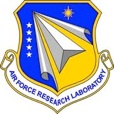
‘Project will further advance interactive 3-D holographic display technology for the Warfighter [Zebra Imaging] will integrate its interactive 3-D holographic display system ... with a United States Air Force Warfighter mission application related to air, space or cyberspace warfare. This new effort follows Zebra's successful execution of a Phase I ... effort during 2009. “The FMHD Phase II contract represents an important step in advancing 3-D technology for military planning and operations," said Dr. Mark Lucente, director of display products at Zebra Imaging. "[It] will reinvent how our Warfighters visualize and interact with complex 3-D data. This near real-time, comprehensive understanding of the battlespace will make for more effective, more survivable operations across the threat spectrum." [It] represents next generation technology in understanding, applying and interacting with 3-D data. The 24-month Phase II effort will demonstrate the utility of dynamic, holographic display and 3-D user interaction specific to the Warfighter's environment. Phase II will also further develop, optimize, and integrate 3-D holographic visualization with Air Force Warfighting missions, data flow, tactics and support structure.’
This press release from Zebra Imaging describes the first-ever customer for a practical holographic display system. This was picked up by many in the news media, including Photonics, Texas TechPulse and MilAero007.

Zebra Imaging inks $750K defense contract
‘The newest offering ... uses 3-D video and allows pilots to view and interact with air space in real-time, from the ground. In the next 24 months, the company will test, optimize, and integrate [it] with Air Force missions, data flow, tactics and support structure.’
Coverage of the contract with the Air Force, representing the first customer for a holographic display system.

2007 April: 3rd Dimension newsletter from Veritas et Visus
Interview with Mark Lucente from Zebra Imaging by Mark Fihn
‘Mark Lucente has developed dynamic holography since its first demonstration in 1990. Along the way, his career has spanned academia, start-ups, and corporate research, and has included innovation in areas as diverse as holography, bio-photonics, artificial intelligence and alternative energy. Dr. Lucente earned his university degrees (Ph.D., S.M. and S.B.) from MIT, specializing in photonics. While at the MIT Media Laboratory (1989- 1995), he invented interactive 3D electronic holographic display technology (“electro- holography”). He has also taught synthetic 3D imaging at Columbia University. During five years at IBM's T.J. Watson Research Center, he designed and built computer systems endowed with “eyes”, “ears” and other “senses” to become a natural part of the work and home environments, and eventually as a natural interface to holographic display systems.’
See page 47-49 of this jam-packed newsletter.

For more information, contact Mark Lucente.
For older press, see the Press Archive.

Updated 2011 Dec 30. Copyright 2011 Mark Lucente







